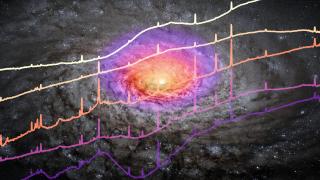Bibcode
Fernández-Torreiro, M.; Cicone, C.; Tadhunter, C. N.; González-Fernández, C.; Acosta-Pulido, J. A.; Ramos Almeida, C.
Referencia bibliográfica
Monthly Notices of the Royal Astronomical Society: Letters, Volume 487, Issue 1, p.L18-L23
Fecha de publicación:
6
2019
Número de citas
33
Número de citas referidas
31
Descripción
Based on new near-infrared spectroscopic data from the instrument
Espectrógrafo Multiobjeto Infra-Rojo (EMIR) on the 10.4 m Gran
Telescopio Canarias, we report the presence of an ionized and warm
molecular outflow in the luminous type-2 quasar J150904.22+043441.8 (z =
0.1118). The ionized outflow is faster than its molecular counterpart,
although the outflow sizes that we derive for them are consistent within
the errors (1.34 ± 0.18 and 1.46 ± 0.20 kpc,
respectively). We use these radii, the broad emission-line luminosities
and in the case of the ionized outflow, the density calculated from the
trans-auroral [O II] and [S II] lines, to derive mass outflow rates and
kinetic coupling efficiencies. While the ionized and warm molecular
outflows represent a small fraction of the AGN power (≤0.033 and
0.0001 per cent of Lbol, respectively), the total molecular
outflow, whose mass is estimated from an assumed warm-to-cold gas mass
ratio of 6 × 10-5, has a kinetic coupling efficiency of
˜1.7 per cent Lbol. Despite the large uncertainty, this
molecular outflow represents a significant fraction ofLbol
and it could potentially have a significant impact on the host galaxy.
In addition, the quasar spectrum reveals bright and patchy narrow
Paα emission extending out to 4 arcsec (8 kpc) south-east and
north-west from the active nucleus.
Proyectos relacionados

Actividad Nuclear en Galaxias: una Perspectiva 3D del Núcleo y su Entorno
Nuestro proyecto puede dividirse en dos líneas principales de investigación. En primer lugar, el estudio de los vientos producidos por cuásares luminosos oscurecidos y del impacto que estos tienen en sus galaxias anfitrionas (retroalimentación del AGN). Para ello hemos obtenido observaciones en el óptico e infrarrojo cercano con el Gran Telescopio
Cristina
Ramos Almeida